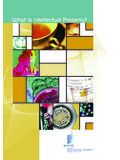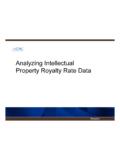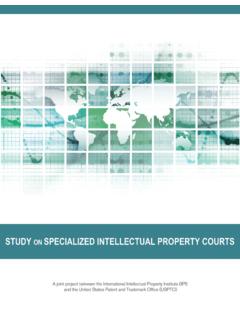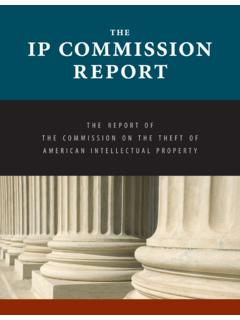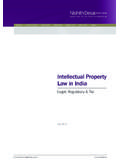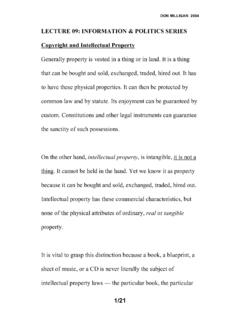Transcription of Intellectual Property Rights and Vaccines in …
1 Background paper for WHO workshopIntellectual Property Rights and Vaccines inDeveloping countriesGeneva 19th-20th April 2004 Christopher GarrisonConsultant Legal Advisor to WHO13 April 2004 This paper was prepared for the purpose of the meeting. The views expressed thereinshould not be taken as representing any policy position or statement of the WorldHealth Organization (WHO).1 Background paper for WHO workshop on IP and VaccinesGeneva 19th-20th April Summary to this paper to IP and Vaccines test data delivery devices , Doha and TRIPS-plus to IP protected vaccine technologies problem and IP can competition to a patented product arise? 15 Box 1: The Hepatitis B Vaccines and competition test data and competition factors delivery devices to increase access pricing purchasing 23 Box 2: IP and procurement licensing licensing and Access conclusions and R&D for Vaccines R&D incentivising R&D and the underlying market sector view:incentives and disincentives for vaccine R&D sector vaccine research (and development?)
2 Partnerships dis-incentivising or hampering R&D? and R&D conclusions , technology transfer and the local production of Vaccines transfer and the TRIPS Agreement transfer and the private sector: business models modes of technology transfer production of Vaccines technology transfer: other factors and Technology transfer conclusions and directions to consider 442 EXECUTIVE SUMMARYThis is a background paper for the forthcoming WHO workshop on IP and Vaccines and isintended to provide an outline of some of the relevant issues for consideration as well assuggested options and directions to issues of access to technologies, research and development (R&D) and technologytransfer are intimately linked.
3 How R&D is carried out will very likely determine theconstraints on access to, and technology transfer of the products of that R&D. The followingsections therefore examine the linked issues of access to IP protected technologies, thestimulation or otherwise of R&D and technology transfer by IP and the context in which allthree Property and access to IP protected vaccine technologiesThe TRIPS Agreement today provides for a number of Intellectual Property Rights that arerelevant to Vaccines , including for example: Patents there are now a wide range of vaccine related inventions that may now bepatented ranging from upstream research related inventions to downstream development, production and delivery related inventions. Undisclosed information Know-how perhaps plays a larger role in vaccineproduction than in medicines and may be regarded as including both certain sorts of undisclosed information ( trade secrets ) and more general knowledge to a greateror lesser extent there seems to exist a know-how gap between OECD vaccinemanufacturers and emerging vaccine manufacturers.
4 Undisclosed test or other data this is a subset of undisclosed information and isimportant in the field of medicines in terms of the use of bio-equivalence toaccelerate regulatory approval it may not be so important for Vaccines in theseterms if each manufacturer has to carry out their own clinical Property monopolies are not absolute. Patent monopolies are for example limitedin terms of scope (what is, and is not, prevented by the patent), in terms of geographicalextent (they are only granted on a country-by-country or occasionally regional basis) and interms of time (they have a (minimum) lifetime of twenty years). Pricing decisions, withincertain limits, are in the hands of the patent owner. If a new vaccine is priced in an affordablefashion then access to that vaccine will be commensurately less difficult.
5 Nevertheless,patents are, by their very design, intended to permit a price to be struck which could not besupported in usual conditions of competition. Due to the limits of patent monopolies,competition to a patented vaccine may arise for example from: Another vaccine which achieves the same or similar result but through the use of adifferent technique. Compare for example a plasma derived vaccine and arecombinant vaccine . How often is a patented vaccine likely to have an effectivecompetitor? A version of the vaccine made in a country where the patent is not in force althoughthis vaccine will not be able to be sold in any countries where the patent is in TRIPS Agreement represents a radical change in this respect all WTOM embers (except Least Developed Country Members) have to permit patents forpharmaceutical products, including Vaccines , by 1st January 2005.
6 Will competitionfrom emerging manufacturers therefore be suppressed? Will global vaccine patent3monopolies become the norm in the future? This can be expected to have a significantimpact on the price of patented Vaccines . A version of the vaccine made after the patent has expired. In terms of the publichealth needs of the developing world it cannot be acceptable to wait for the patent toexpire. There are mechanisms available in theory under the TRIPS Agreement toenable competition during the lifetime of the patent, compulsory licensing, butfactors such as know-how may impact their hypothesis has been advanced that Intellectual Property does not significantly impactaccess to Vaccines through for example raising prices. The argument is made that in forexample the case of the recombinant DNA Hepatitis B Vaccines , the maximum patent licenceroyalty rate was 15%.
7 However, since a patent owner and licensee are in effect in a managedrelationship, it is likely that the more significant contribution to price will arise from the factthat the patented vaccine may not experience any true competition. In fact it appears that therecombinant DNA Hepatitis B vaccine experienced price competition from a plasma derivedHepatitis B vaccine , and so cannot seemingly be relied upon as a good example of how a worst case patent monopoly will impact vaccine the WTO Doha Declaration on TRIPS and Public Health , new, bilateraland regional Free Trade Agreements are being agreed that bind the parties to TRIPS-plus protection (higher standards than the TRIPS Agreement requires), such as: Longer patent lifetimes to make up for time lost in the regulatory approval process Linking patent issues into the regulatory approval processAlthough the full impact of the TRIPS Agreement on public health in the developing world isnot yet known, these supplementary agreements will further strengthen Intellectual propertyright UK Commission on Intellectual Property Rights (CIPR) expressed concern at thereduction of competition that the TRIPS Agreement will likely bring and called for ways to befound, within the patent system and without, to generate the necessary competitiveenvironment to help offset the adverse price effects of patents on developing that have been used to facilitate access to patented Vaccines include.
8 Tiered pricing this is a traditional mechanism for facilitating access to is in part because parallel importation tends not to take place given the coldchain nature of vaccine distribution. However the phenomenon of scheduledivergence , where different vaccine products are now provided to segments ofmarkets that used to share a single vaccine product, may threaten the use of tieredpricing in the future. Bulk purchasing this is also a traditional mechanism for facilitating access tovaccines due to the importance of vaccine production scale issues and the need topredict demand. Procurement processes of the sort that were so successful inreducing the price of the Hepatitis B vaccine (the Hepatitis B Task Force sealed bidtender) may face difficulty (post 1st January 2005) as global vaccine patentmonopolies tend to increase the likelihood of encountering single Voluntary licensing voluntary licensing may take a number of different formsstarting from a bare patent licence, through permitting the licensee to carry out acertain stage of the vaccine production process, to a full technology transfer to put thelicensee in the same position as the patent owner.
9 Business model considerations willapply and as noted above, it cannot be expected that voluntary licensing willnecessarily result in the same reductions in price that would appear in a trulycompetitive situation. Compulsory licensing a compulsory licence can be granted where for example thepatent holder has abused their monopoly or where it is otherwise in the publicinterest. Whether or not the necessary know-how is possessed by a potentialcompulsory licensee will impact the effectiveness of compulsory of these, or other mechanisms, is going to play a role in facilitating access to patentedvaccines in the future?IP and R&D for vaccinesHow R&D is carried out will to a great extent determines access to the products of that R& predominant mode of (private sector) R&D incentivisation is through intellectualproperty and the TRIPS Agreement and consequently the section above deals with access toIP protected products, and the section below deals with IP framed technology transfer.
10 It isnot possible to divorce the effectiveness of the Intellectual Property in stimulating R&D fromthe viability of the underlying market for the product of that R&D. There are a number ofpossibilities for different health R&D approaches: The possibility of a patent monopoly in a rich market, promising profit, can beexpected to encourage private sector R&D. The possibility of a patent monopoly in apoor or non-existent market, promising little or no profit, can be expected toencourage little or no private sector R&D, as the UK Commission on IntellectualProperty Rights (CIPR) found. The private sector R&D programmes that arepresently observed also support this thinking. By way of confirmation of thisproblem, measures supplementary to Intellectual Property are being discussed and/orprovided to try to incentivise the private sector further.










